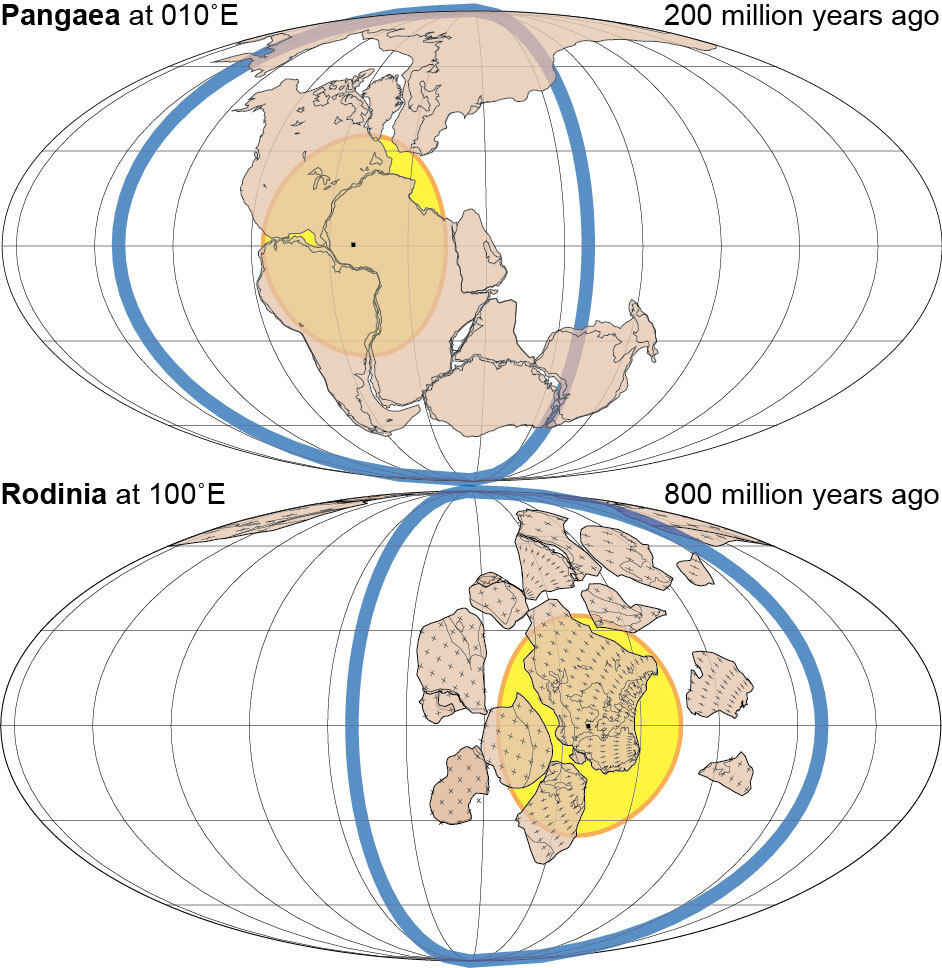How Many Years Until Pangea Again
The Earth'southward continents are in constant motion. On at to the lowest degree 3 occasions, they have all collided to grade one giant continent. If history is a guide, the current continents will coalesce once once more to form another supercontinent. And a written report in Nature now shows how that could come up about.
Y'all tin can think of continents equally behemothic puzzle pieces shuffling effectually the Earth. When they drift apart, mighty oceans grade. When they come together, oceans disappear. And it's all because continents sit on moving plates of the Earth's crust.
A new model of continental migrate predicts that the next supercontinent could grade nigh the N Pole — in another 100 1000000 years or so.

Two of the previous supercontinents, which formed 200 million years ago (Pangaea) and 800 million years ago (Rodinia). Mitchell, et. al./Nature hide explanation
toggle caption
Mitchell, et. al./Nature

Two of the previous supercontinents, which formed 200 1000000 years ago (Pangaea) and 800 meg years ago (Rodinia).
Mitchell, et. al./Nature

The Americas and Asia may fuse together to grade a new supercontinent, "Amasia." Mitchell, et. al./Nature hide caption
toggle caption
Mitchell, et. al./Nature

The Americas and Asia may fuse together to form a new supercontinent, "Amasia."
Mitchell, et. al./Nature
"Continents on these plates typically movement, I would say, at the rate your fingernails grow," says Ross Mitchell, a graduate student at Yale University. That may seem dull, only it adds up over hundreds of millions of years.
Await at an atlas and you lot can imagine how Africa and South America, for case, once nestled together.
"Rewind the tape and bring all the continents back into their jigsaw arrangement, you lot have this vast landmass of all the Earth'southward continental blocks together," Mitchell says.
Final fourth dimension all the landmass clumped upwards, it formed a supercontinent chosen Pangaea. The dinosaurs walked there. Merely Pangaea wasn't the first.
"At that place had been 3, maybe a debated quaternary supercontinent through the billions of years," Mitchell says.
He has been studying that deep history by looking at tiny magnets cached in rock around the world. Those magnets pointed n when they were locked into the rock. Sample those magnets in layers of stone laid downwardly over millions of years, and you lot tin can tell the story of how those continents have moved.
And naturally, that led Mitchell to wonder what the adjacent supercontinent will look like.
In that location take been two leading ideas. One is that the continents volition collapse together over again at the site of the terminal supercontinent, centered on Africa. That would clasp the Atlantic Ocean shut. The other idea is that the Atlantic would keep growing and growing.
Under this scenario, "a supercontinent rifts apart, and the continents skirt around to the contrary side of the world, re-creating the adjacent supercontinent, 180 degrees on the opposite side of the earth from the previous ane," Mitchell says.
That would leave us with a supercontinent in place of the Pacific Body of water.
A Supercontinent Called Amasia
Only Mitchell's research for his Ph.D. thesis suggests both those ideas are incorrect. Instead, he says the continents seem to exist moving north. That means the Caribbean Sea and the Arctic Ocean will be squished shut.
"Think nearly closing the Caribbean Sea — you have now fused North and South America," Mitchell says. "So past fusing the Arctic Ocean, you would suture the Americas with Eurasia."
850 Million Years Of Drifting
The country on Earth is moving, only slowly — most every bit fast as your fingernails grow. If we turn the clock back 850 meg years, we tin come across how the continents grew apart and back together several times.
That would create a supercontinent called Amasia that would course at the top of the World. Eventually it would slump south toward the equator. And under this scenario, Antarctica might remain isolated at the bottom of the world.
Brendan Potato studies supercontinents at St. Francis Xavier University in Nova Scotia. He says the Yale team's thought is provocative, innovative and plausible.
"What they've done is they've thrown another possibility out there that, quite bluntly, many of us hadn't really idea about. And so fifty-fifty if the model is wrong, nosotros volition learn a lot past testing it."
And he says the challenge isn't simply finding different ways to put together the Earth'southward jigsaw puzzle continents.
"This is really important considering it influences the development of our entire planet, including life that lives on information technology," Irish potato says. "For example, many people believe that supercontinents form and stood apart their primal changes in climate."
Of grade, the next supercontinent isn't likely to form for another 100 million years or so. And Mitchell says the human species will probably be long gone by then, and so we won't know, "simply it's certainly fun to recall about."
Source: https://www.npr.org/2012/02/08/146572456/amasia-the-next-supercontinent
0 Response to "How Many Years Until Pangea Again"
Post a Comment